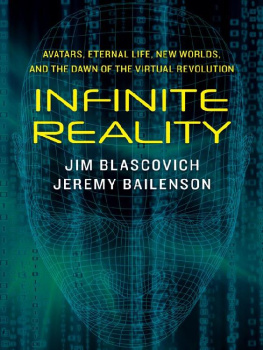R IGHT NOW, WERE INSIDE A COMPUTER PROGRAM ?
With that monotone query, a very confused Neo, played by Keanu Reeves in the blockbuster film The Matrix, convinces hundreds of millions of viewers that virtual reality could be so real that people have no idea they are actually living in a simulation. Of course, The Matrix is just a movie, but brain science supports many of the ideas of the Wachowski brothers, who wrote, directed, and produced the film.
The brain often fails to differentiate between virtual experiences and real ones. The patterns of neurons that fire when one watches a three-dimensional digital re-creation of a supermodel, such as Giselle or Fabio, are very similarif not identicalto those that fire in the actual presence of the models. Walking a tightrope over a chasm in virtual reality can be a terrifying ordeal even if the walker knows its virtual rather than physical.
People interact via digital stimuli more and more. According to a recent study by the Kaiser Family Foundation, kids spend eight hours per day on average outside of the classroom using digital media. This translates to billions of hours per week. People interact with virtual representations in just about every facet of lifebusiness transactions, learning, dating, entertainment, even sexual relationships. Online dating, which used to be somewhat stigmatizing, is now normative. Young adults consider their Facebook friends just as important as the people who live close enough to meet physically. In the world of online games and virtual worlds, millions of players spend over twenty hours each week wearing avatars, digital representations of themselves. Strikingly, the average age of these players is not fifteen but twenty-six. Household console video arenas, especially games, in which people control and occupy avatars, consume more hours per day for kids than movies and print media combined. To borrow a term from the new vernacular, virtual experiences are spreading virally.
Technological developments powering virtual worlds are accelerating, ensuring that virtual experiences will become more immersive by providing sensory information that makes people feel they are inside virtual worlds. In the United States, Nintendos Wii, often coupled with a huge high-definition television, populates many living rooms. The players physical actions are transformed into virtual body movements in the game. By the time you read this, Nintendos Wii, Microsofts Kinect, and Sonys PlayStation Move may incorporate 3-D displays. Virtual experiences are no longer embodied just by hunting and pecking on a keyboard or using a joystick: digital characters now move in tandem with players as they jump around, point guns, and swing racquets, golf clubs, and baseball bats.
Stereo, 3-D visual media technologywhich not that long ago was only available to scientists and people using View-Masterspromises to change the film, television, and game industry. Movie theaters entice audiences willing to pay a few extra dollars for 3-D glasses to watch blockbuster films. The game and television industry are promoting 3-D monitors to every household. The popular sports network ESPN even broadcasts in 3-D.
Although we arent yet jacking in to the virtual world via a plug in the back of our head, as Neo did in The Matrix, digital media are providing more realistic experiences and not just for humans. Ten years ago, most household pets ignored television. Today, high-definition television transfixes, thrills, and sometimes enrages dogs and cats as they watch the fare on the Animal Planet network. They simply do not differentiate the digital image from reality.
This leads to an interesting propositionthe brain doesnt much care if an experience is real or virtual. In fact, many people prefer the digital aspects of their lives to physical ones. Imagine you never aged, could shed pounds of cellulite, or put on muscle mass at the touch of a button. Think about never having a bad-hair day, expressing an involuntary grimace, or getting caught staring. Think also about a world with no putrid smells but plenty of delightful ones, when it rains only when you are inside, and where global warming is actually just a myth. In this world, your great-grandfather is still around and can play catch with your six-year-old daughter. There is no dental drill or swine flu in this place.
But there are consequences to people occupying idealized digital worlds. This quandary is thematic in James Camerons film Avatar, which took in more money than any prior film in United States history. In it, Jake Sully, a paraplegic soldier confined to a wheelchair, dons a virtual body of a member of another species, the Navi, on a distant planet. With avatar arms and legs, as well as a tail, he runs through jungles and swings through trees. He even falls in love.
On the one hand, Avatar depicts many wonderful aspects of virtual reality. In the natural world, physically disadvantaged people are denied many behaviors that most take for granted. In the virtual world, people can choose whether their avatars have fully functioning bodies, regardless of their physical condition. One of the most popular virtual worlds, Second Life, has a higher proportion of physically challenged users than the general population, allowing them to shed any stigmatization they experience in the physical world. Paraplegics can not only walk and run again, but actually can fly through the air or teleport themselves thousands of (virtual) miles in an instant.
On the other hand, Jake learns that wearing his Navi avatar has emotional consequences. He is a human being at the beginning of the movie, but as he spends more and more time wearing his giant blue alien avatar, he loses his humanity. By the end of the film, Jakes psychological bond with his avatar is so strong that he abandons his ties to the human race.
Avatar s fiction is supported by science: dozens of psychological experiments have shown that people change after spending even small amounts of time wearing an avatar. A taller avatar increases peoples confidence, and this boost persists later in the physical world. Similarly, a more attractive avatar makes people act warm and social, an older avatar raises peoples concern about saving money, and a physically fit avatar makes people exercise more.
Outside of scientific laboratories, avatars can be a matter of life or death. On the positive side, an avatar can be immortal. Consider the case of Orville Redenbacher, who is still the spokesperson for the popcorn company, even though he passed away years back. Using video footage from commercials starring Mr. Redenbacher, advertisers were able to construct a digital model that looks just like him and can be animated to perform any action imaginable. So the popular spokesperson is now acting in new advertisements from beyond the grave. There are commercial services today that will immortalize anyone who would like their avatars created and stored.
On the negative side, avatars can be sources of trauma. Consider the horrific case of a thirteen-year-old girl who committed suicide when she found out the boy with whom she interacted online wasnt who she thought he was. He was a fictional character created by others, who planned to hurt her feelings. She formed a strong attachment to the online persona. When she discovered he was fictional, she was devastated. In a less tragic but still disturbing event, in the early days of the Internet, there was a well-known rape case in cyberspace, in which one online user, via text, violated another in a virtual chat room. The victim, while physically unharmed, was traumatized.












